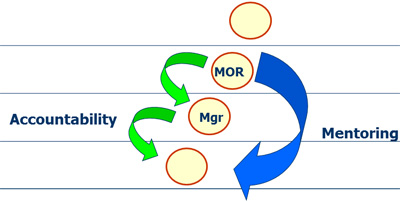From the Ask Tom mailbag:
Question:
You have talked about the role of the Manager Once Removed. In our company, that role is not encouraged and in some cases, we have been told that it undermines the authority of the reporting chain. How do you explain this role, where a manager skips a layer in the org chart and interacts with team members two layers below?
Response:
Let’s start with a hidden land mine in your question. Your description of the organization as a reporting chain sets up a dysfunction that inhibits healthy and productive interaction between team members and their managers, one and two layers above.
We Report to Lots of People
We report to people all over the organization. I may be responsible for a project segment on an ad-hoc team. I have to produce a number that is part of a financial report for accounting. I provide feedback to the sales team for available inventory. I report to people all over the organization. But I can have only one manager.
Management as a Value Stream
Managers do not exist so people can report to them. Managers exist to create a value stream for problem solving and decision making to their teams one and two layers below. Every employee is entitled to have a competent manager with the capability to bring value to their problem solving and decision making.
With this understanding, we can now examine how the Manager Once Removed (MOR) can create positive, healthy relationships with their team members one and two layers below. We can actually measure these relationships, using Time Span, to specifically determine the accountability in each of these relationships.
What is the nature of the relationship between the Manager and the Team Member? What are their conversations about? What is the work being done in this relationship? What is the Time Span of the work in this relationship?
Between Stratums I and II, the conversations are all about the work, defined as direct output. What your customer experiences in your product or service, is most often the direct output in this relationship. The conversations between the Manager and the Team Member are about pace and quality. The Time Span of the work is typically short, based on production cycles.

Between Stratums I and III, between the Team Member (I) and the Manager Once Removed (III), the relationship changes, the conversation changes, the Time Span changes. In this necessary relationship, the MOR looks at longer Time Span issues, like efficiencies, sequence of work steps, working conditions, workflow configurations. The MOR also looks at the people system, monitors who might be ready for additional responsibilities, more complex challenges and leadership roles. The Time Span of this work is longer term, based on the growth of the organization and the natural maturity of team members progressing in their roles.
Because LIFE HAPPENS, the Manager at Stratum II will eventually turn over. That manager may be promoted, moved to another department or may re-locate. The Manager Once Removed (III) becomes the Hiring Manager to replace that position. The relationship of the MOR (III) with the Team Members (I) provides the necessary data for the hiring decision. Is there anyone on the team ready to step up or do we have to go outside and recruit?
This managerial web, managers involved in coaching and MORs involved in mentoring, makes for a healthy organization ready for change and challenge.
